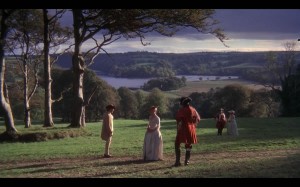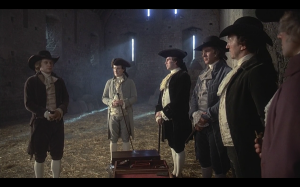 Based on the 1844 novel by William Makepeace Thackeray, the story chronicles the rise and fall of Irishman Redmond Barry (Ryan O’Neal). His ascent in society through a mixture of luck and deviousness finds him rubbing shoulders with the aristocracy. He eventually finds himself husband to a wealthy and beautiful widow, father to newborn son and enemy to an estranged step-son. Oh and a new title granted to him by the king of the name “Barry Lyndon”. Cue his descent; a demise, our narrator informs us, which leaves him poor, lonely and childless. Lo and behold, that’s what happens. The End.
Based on the 1844 novel by William Makepeace Thackeray, the story chronicles the rise and fall of Irishman Redmond Barry (Ryan O’Neal). His ascent in society through a mixture of luck and deviousness finds him rubbing shoulders with the aristocracy. He eventually finds himself husband to a wealthy and beautiful widow, father to newborn son and enemy to an estranged step-son. Oh and a new title granted to him by the king of the name “Barry Lyndon”. Cue his descent; a demise, our narrator informs us, which leaves him poor, lonely and childless. Lo and behold, that’s what happens. The End.
The highlight of this film, like most of Kubrick’s work, is the splendid cinematography owed to it by cinematographer and regular collaborator John Alcott. The film was shot using superfast 50mm lenses (developed originally for NASA) The secret to these lenses was their huge aperture (f/0.7 – to date the lowest f/stop in film history) This meant that for the most part they could abandon artificial lighting and even shoot scenes in just candle-light. There is no denying either that the numerous vista shots in the film are crisper than most HD cameras could dream of.
 It was originally met with mixed reviews and was not a commercial success. This does not surprise me. Few films that long (2hrs50m) rarely are. It appears to have enjoyed a fashionable reprise of late, but I shan’t be jumping on the bandwagon myself. The film plods rather like the coarse version of Handel’s “Sarabande” that features heavily like some Clockwork Orange signature tune. Having not read the original Thackeray novel, I cannot compare whether the story being told is well serving to it. Despite a narration of the story from Michael Horden (which sometimes made you feel like you were watching Paddington Bear), the film’s telling of it leaves one feeling a little detached from its characters. By the end I cared very little for any of them.
It was originally met with mixed reviews and was not a commercial success. This does not surprise me. Few films that long (2hrs50m) rarely are. It appears to have enjoyed a fashionable reprise of late, but I shan’t be jumping on the bandwagon myself. The film plods rather like the coarse version of Handel’s “Sarabande” that features heavily like some Clockwork Orange signature tune. Having not read the original Thackeray novel, I cannot compare whether the story being told is well serving to it. Despite a narration of the story from Michael Horden (which sometimes made you feel like you were watching Paddington Bear), the film’s telling of it leaves one feeling a little detached from its characters. By the end I cared very little for any of them.
Well, perhaps there was one. A superb performance at the start of the film from Leonard Rossiter as the cowardly courtier Captain John Quin. And Kubrick regular Phillip Stone makes a brief appearance towards the end – Stone would later become instantly recognisable as Delbert Grady, the original caretaker in ![]() The Shining.
The Shining.
[rating=2]